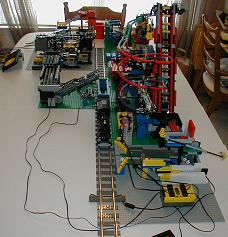
The Great Ball Contraption
"It can be really simple, or devilishly complex as time allows!"
 |
The Great Ball Contraption "It can be really simple, or devilishly complex as time allows!" |
Translations:
Can't read English? Try these pages:
French - FreeLUG
Italian - ItLUG
Polish
Japanese
Danish - coming soon
Other Team Hassenplug stuff...
Idea:
Develop a Mindstorms/Technic creation (not competition) in which people of all building levels can participate. Each person can build one (or more) module(s). All modules will be assembled to form a large "Rube Goldberg "-ish bucket-brigade type contraption.
With other themes, Adult Fans of LEGO (AFoLs) have designed standards, that allow people in different geographic locations to build sections that will be included in a common display. A couple examples are the Moonbase and Classic Castle standards.
We plan to assemble a Great Ball Contraption at BrickFest '05 (http://news.lugnet.com/robotics/?n=23244 )
|
This started as a "Ping Pong ball handoff" within our club (The Lafayette LEGO Robotics Club or LafLRC), and was combined with SMART's Crate Contraption to become The Great Ball Contraption . The goal is to pass LEGO soccer balls from one module to the next. Each module can be as simple, or as complex as a builder wants. |
Type 1 interface standard:
|
Standard module layout |
|
Here are some sample module layouts.
With the Type 1 interface, only balls are passed from one module to the next. In the future, Crates may also be passed back and forth.
Type 1b interface standard:
The Type 1b standard is a subset of Type 1. This type of module can easily be included into a train layout. In Type 1b, all modules are built on one or more 32x32 baseplates (in a straight line).
It's also recommended that Type 1b modules have an even higher throuput rate than 1 ball per second, because they will usually be displayed in GBCs with fewer modules, so a higher throughput should keep it interesting.
Building Notes:
This simple interface should offer plenty of flexibility. The distance from the back of the module to the input/output must be no greater than 32 studs, because when this Great Ball Contraption is assembled, it may be located against a wall, and that will allow a uniform distance to/from the wall.
The distance in front of the bin is not limited, but it's recommended that the module's width be greater than its depth.
The throughput rate of 1 ball per second does sound fast, but this will be required to keep balls from building up in the input of a slower module. The actual rate may be closer to 2/3 balls/sec.
Currently, there is no standard for physically connecting modules together. Most, but not all modules will be assembled on some sort of baseplate, and it's assumed these plates can be connected together.
The tank treads from the Mindstorms kit seem like they should as a really nice belt to move balls up a small hill. BUT, THEY DON'T.
Another suggestion when building modules: Many RCX controlled modules will wait for a section to "fill-up" before dumping. Then, it may go through a sequence of moves, before returning to it's "waiting" state. It's actually a good idea to put the "wait" at the end of the sequence. That way if the module is off, while the previous module is running, the first thing it will do is empty itself, instead of waiting to overflow, before unloading.
Here is information about how you can break the standard.
How fast is 1 ball per second?
If you want to make a GBC module that uses a
single motor, and runs at a constant speed of at least 1 ball per second,
how fast must it go? Normal Mindstorms motors run around 360 RPM or ~6
revolutions per second. Here are some really rough figures...
If the motor is connected via 8 tooth to 24 tooth gears, that's 2
rev/sec
8 to 40 = 1.2 rev/sec
worm to 24 = .25 rev/sec (must deliver 4 balls per rev)
worm to 8 =
.75 rev/sec
Balls:
LEGO makes several different types of soccer balls, with different patterns. Any of them will work. However, about the only place to buy them is from Bricklink
Samples:
Here are a few images & videos from our first couple get-togethers.
Several pictures taken from video and several other GBCs
These videos are hosted by a server that's not always available. But, they are big, so I'm just going to leave them there. If you can't see them now, check back later.
A high quality video of one ball moving through the contraption (15 mb)
The train running in a loop. (13mb)
Bryan firing off balls in random directions (6mb)
Long version of GBC 2.0 (36mb)
GBC 6.0 (39mb)
GBC Friends:
According to the French version of these rules posted on FreeLUG (and babblefish) it's called the "Large Thingummy with Balls"
Ideas:
Do you need ideas on what to build? Here's a list of possibilities, compiled by Brian Davis .
Other:
Brian Alano has collected some other good stuff here.
More info:
For more info, contact me (Steve@teamhassenplug.org), or Brian Davis (brdavis@iusb.edu)
This standard is still in-progress, and will be adjusted as necessary.
Last Updated May 31, 2005